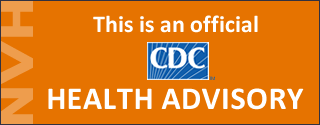Increased Interseasonal Respiratory Syncytial Virus (RSV) Activity in Parts of the Southern United States
Distributed via the CDC Health Alert Network
June 10, 2021, 1:30 PM ET
CDCHAN-00443
Summary
The Centers for Disease Control and Prevention (CDC) is issuing this health advisory to notify clinicians and caregivers about increased interseasonal respiratory syncytial virus (RSV) activity across parts of the Southern United States. Due to this increased activity, CDC encourages broader testing for RSV among patients presenting with acute respiratory illness who test negative for SARS-CoV-2, the virus that causes COVID-19. RSV can be associated with severe disease in young children and older adults. This health advisory also serves as a reminder to healthcare personnel, childcare providers, and staff of long-term care facilities to avoid reporting to work while acutely ill – even if they test negative for SARS-CoV-2.
Background
RSV is an RNA virus of the genus Orthopneumovirus, family Pneumoviridae, primarily spread via respiratory droplets when a person coughs or sneezes, and through direct contact with a contaminated surface. RSV is the most common cause of bronchiolitis and pneumonia in children under one year of age in the United States. Infants, young children, and older adults with chronic medical conditions are at risk of severe disease from RSV infection. Each year in the United States, RSV leads to on average approximately 58,000 hospitalizations1 with 100-500 deaths among children younger than 5 years old2 and 177,000 hospitalizations with 14,000 deaths among adults aged 65 years or older.3
In the United States, RSV infections occur primarily during the fall and winter cold and flu season. In April 2020, RSV activity decreased rapidly, likely due to the adoption of public health measures to reduce the spread of COVID-19.4 Compared with previous years, RSV activity remained relatively low from May 2020 to March 2021. However, since late March, CDC has observed an increase in RSV detections reported to the National Respiratory and Enteric Virus Surveillance System (NREVSS), a nationwide passive, laboratory-based surveillance network. CDC noted increases in laboratory detections and in the percentages of positive detections for both antigen and PCR testing in parts of HHS Region 4 (Alabama, Florida, Georgia, Kentucky, Mississippi, North Carolina, South Carolina, and Tennessee) and Region 6 (Arkansas, Louisiana, New Mexico, Oklahoma, and Texas). Due to limited testing outside of the typical RSV season, data are limited in some jurisdictions and may be incomplete for the most recent weeks. Since this elevated interseasonal activity is a deviation in the typical circulation patterns for RSV, at this time it is not possible to anticipate the likely spread, peak, or duration of activity with any certainty. Health officials also identified increased interseasonal RSV circulation in parts of Australia during late 2020 and in South Africa in early 2021. Still, RSV did not reach seasonal peak levels in most regions or result in widespread circulation.5-7
Due to reduced circulation of RSV during the winter months of 2020–2021, older infants and toddlers might now be at increased risk of severe RSV-associated illness since they have likely not had typical levels of exposure to RSV during the past 15 months. In infants younger than six months, RSV infection may result in symptoms of irritability, poor feeding, lethargy, and/or apnea with or without fever. In older infants and young children, rhinorrhea and decreased appetite may appear one to three days before cough, often followed by sneezing, fever, and sometimes wheezing. Symptoms in adults are typically consistent with upper respiratory tract infections, including rhinorrhea, pharyngitis, cough, headache, fatigue, and fever. There is no specific treatment for RSV infection other than symptom management.
Recommendations
- Clinicians and caregivers should be aware of the typical clinical presentation of RSV for different age groups.
- Clinicians should consider testing patients with a negative SARS-CoV-2 test and acute respiratory illness or the age-specific symptoms presented above for non-SARS-CoV-2 respiratory pathogens, such as RSV. Real-time reverse transcription-polymerase chain reaction (rRT-PCR) is the preferred method for testing for respiratory viruses.
- Clinicians should report laboratory-confirmed RSV cases and suspected clusters of severe respiratory illness to local and state health departments according to their routine reporting requirements.
- Healthcare personnel, childcare providers, and staff of long-term care facilities should avoid reporting to work while acutely ill – even if they test negative for SARS-CoV-2.
- Clinicians can review weekly updates to the NREVSS website and refer to surveillance data collected by local hospitals and health departments for information on RSV circulation trends in their area.
For More Information
- CDC – RSV Information for Healthcare Providers
- CDC – RSV National Trends – NREVSS
- CDC – RSV Trends and Surveillance
- CDC – RSV Symptoms and Care
6Virus Watch, Week Ending 30 May 2021. Government of Western Australia, Department of Health. Accessed 6/7/2021.
7Weekly Respiratory Pathogens Surveillance Report, South Africa, Week 21, 2021. National Institute for Communicable Diseases, Division of the National Health Laboratory Service. Accessed 6/7/21.
The Centers for Disease Control and Prevention (CDC) protects people’s health and safety by preventing and controlling diseases and injuries; enhances health decisions by providing credible information on critical health issues; and promotes healthy living through strong partnerships with local, national and international organizations.
Department of Health and Human Services
HAN Message Types
- Health Alert: Conveys the highest level of importance about a public health incident.
- Health Advisory: Provides important information about a public health incident.
- Health Update: Provides updated information about a public health incident.
###
This message was distributed to state and local health officers, state and local epidemiologists, state and local laboratory directors, public information officers, HAN coordinators, and clinician organizations.
###

